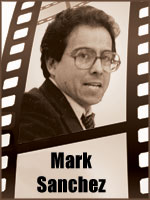 The Smackdown
The Smackdown
Hand it to filmmaker Tim Burton for audacity. It’s career-defining / career-threatening to revamp an acknowledged masterwork like Sweeney Todd: The Demon Barber of Fleet Street. This operatic tale of bloody revenge earned eight Tony awards and a legacy of acclaim after its Broadway debut in 1979. I left the Uris Theatre 28 years ago numb from the soaring score, the spectacle, the blood. It remains a sublime achievement of the world stage. This demon barber has appeared in one form or another for 150 years – there’s even a Sweeney Todd movie that came out in 1936. The version that became a legend is the Stephen Sondheim / Hugh Wheeler musical adapted from Christopher Bond’s play. This stage production was taped in 1982 and is readily available on DVD.
Several recent efforts to translate this material on film fell apart. Now Tim Burton (Edward Scissorhands, Batman, Beetlejuice, Ed Wood) steps up with Johnny Depp in the title role. It’s a risky project since film and stage have distinct conventions that rarely travel well. And there’s the subject matter. Perhaps Tim Burton put it best: “It’s not a stage thing. It’s a movie. Go for it.” Very well. That’s the challenge in our Smackdown: Does Sweeney Todd on film meet the standard set by the stage production in this tale of Oven Baked Vengeance Set to Music?
The Challenger
A sailing ship docks in the foggy, dark London of gaslights and workhouses. It discharges Benjamin Barker, plucked from the ocean after being wrongly exiled to Australia for 15 years. He returns to a landscape reeking of filth and decay. Barker wants revenge for the loss of his wife and daughter, Johanna. As Sweeney Todd he’ll get it. He directs his rage at his nemesis, Judge Turpin (Alan Rickman) after learning the scoundrel made Johanna his ward. Todd is reacquainted with old haunts and resumes his trade as a barber with the help of the amoral schemer Mrs. Lovett (Helena Bonham Carter). The blood flows, the bodies drop and Mrs. Lovett bakes Sweeney’s victims into her pies. She never tells Sweeney the whole truth and it propels the action toward devastation. In Tim Burton’s hand everything is rendered in ghastly scarlet detail.
The Champion
Sweeney Todd 1982 combines spectacle and economy in a stage production showing London during the Industrial Age. It features a revolving square set that serves as Mrs. Lovett’s pie shop, her parlor, and Todd’s upstairs shop with that hinged barber chair that slides victims into Mrs. Lovett’s prep room. It perfectly suits the dark cynicism of the lyrics and razor play. Every important character – especially Angela Lansbury as Mrs. Lovett and George Hearn as Todd – smartly moves the action in word and song. The lighting, staging by Harold Prince and full orchestra make this Sweeney Todd unforgettable. The original production won eight Tony and nine Drama Desk awards; this taped version won three Emmys and four ACE awards. Stage revivals with different performers in 1989 and 2005 earned another two dozen award nominations. By any guise this material drives home the destructive power of lost love, madness and revenge.
The Scorecard
Tim Burton recognized this material demands a different storytelling approach on film. That led to the first difficult creative decision: addition by subtraction. The film Sweeney discards the musical’s signature opening number, cuts other songs and trims the text. John Logan wrote the screenplay. After that, who will perform the roles – and can they sing? On that score Sweeney Todd 2007 does not disappoint. Johnny Depp looks right as the tortured barber bent on murderous payback. He sings well enough to be credible, and so does Bonham Carter as Mrs. Lovett. Her acting is strong enough to counteract her excessive eye shadow. Her character is not haunted and too often she looks like a raccoon. The casting is strong: Alan Rickman perfectly reflects the morally corrupt Judge Turpin – and he can sing. Timothy Spall is repellently effective as the Judge’s pig-faced beadle, Bamford. Sacha Baron Cohen and Edward Sanders shine in minor roles.
None of this would matter without Tim Burton’s dark and comic vision. His mobile camera gives visual interest to material appropriate for the stage, but potentially static on the screen. This Sweeney paints a desperate, older London in sepia-tones that sharply contrast the deadlier elements of the story. Once the blood flows the victims die with no comforting distance. This is in your face, on your face. This will seem excessive to some, but it fits the material. Large emotions, irreversible actions on a bright red day.
Sweeney Todd 2007 represents a giant risk on many levels: It restructures a classic work in service to the quirky vision of a highly talented filmmaker. The film faces uncertain prospects for the studios that ponied up the $50 million production costs. Will Sweeney Todd revive the flagging appetite for movie musicals?
Have we seen enough to decide if Sweeney Todd the film succeeds as well as the stage production that inspired it? Yes.
The Decision
This is a remarkably easy call. As a stage production Sweeney Todd engages the imagination in a way that will always be fresh and compelling. Angela Lansbury, George Hearn and Len Cariou (the original Todd on Broadway) give performances that endure as the gold standard for the stage.
Sweeney Todd 2007 upholds that standard. The streamlining improves the storytelling on film and exploits the strengths of the medium. This Sweeney succeeds grandly as both movie and musical. It is not for the squeamish and this is Tim Burton’s best film in a distinctive career. No surprise there:Â Burton never had better material. Stephen Sondheim said he loves it. That says everything.
We’re lucky to have the Broadway Sweeney Todd on DVD. You’ll say the same thing now and later about “Sweeney Todd” 2007. It wins big, and memorably.

the 1982 version is better…… in my opinion. the 2007 version is just too fast and skips many important details.